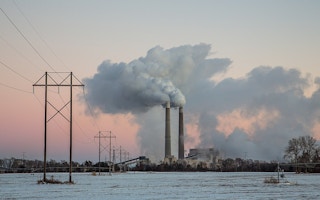Coal is a stranded asset. This point could not have been made clearer this year when Japan, China, and Korea, all heavily reliant on coal, announced commitments to reduce climate change-related emissions to net zero. This means climate emissions will have to be balanced with those absorbed by nature or captured and taken out of the atmosphere. In fact, net zero commitments now make up more than half of global GDP.
To continue reading, subscribe to Eco‑Business.
There's something for everyone. We offer a range of subscription plans.
- Access our stories and receive our Insights Weekly newsletter with the free EB Member plan.
- Unlock unlimited access to our content and archive with EB Circle.
- Publish your content with EB Premium.
While coal and other fossil fuels have fuelled much of the economic growth and prosperity since the industrial revolution, its use has also brought widespread environmental destruction, health issues and governance failures in many countries.
In a net-zero emissions world, stopping the use of coal to generate energy or heat is unavoidable. Based on research by the IPCC, the UN body that analyses climate science, this step must be completed by 2040 at the latest, which means many existing coal plants will be retired early and become stranded assets.
Stranded assets are assets that at some time prior to the end of their economic life—as assumed at the investment decision point—are no longer able to earn an economic return as a result of changes associated with the transition to a low-carbon economy.
In Asia, financial institutions are therefore already starting to exit from coal. A recent ambitious commitment from Malaysia’s CIMB made it the first Southeast Asian bank outside of Singapore with a policy to exit from coal finance.
While most banks only talk about direct project finance, CIMB notably has ended both general corporate finance and asset-level project finance to coal. This is important because corporate finance deals with coal-intensive companies are just as exposed to the risk of asset stranding as direct investments in power plants. The restrictions on corporate finance to coal are a sensible move for CIMB which other banks would do well to follow. Most recently, RCBC joined the wave of regional banks exiting from coal, becoming the first bank in the Philippines to announce a coal exclusion policy.
Loopholes in coal financing policies can lead to risky investments
WWF’s recent analysis of the energy policies of banks in the region showed that most banks with coal policies in the region do not currently have policies that restrict lending to corporate finance for coal. However, this will likely have to change since this is a loophole that could leave banks exposed to risky investments that will end up as ‘stranded assets’, though exceptions may be considered for borrowers moving away from coal.
On top of considering direct investments to coal plants, banks also need to think about developers of coal projects, such as Singapore energy firm Evolution Power Investment Corporation (EPIC), which is set to invest in a $1.7bn coal plant in Laos.
Among other risks, the proposed coal plant in Laos’s Sekong Province would have dangerous air pollution impacts for local communities, as pollutants like sulfur dioxide are released, as well as water pollution impacts. A recently built coal-fueled plant in Hongsa was evaluated by health experts who found that the plant put locals at risk of developing severe health problems such as cancer due to heavy metal contamination in the water supply and air pollution.
Meanwhile, sustainable energy options show a great potential to fulfil national energy needs while creating jobs, improving air quality and lowering long-term energy costs. As demonstrated in the Power Vision 2050 Report published by the WWF Greater Mekong team, it is technically feasible to supply the Lao population in 2050 with the electricity they need, with nearly 100 per cent of this coming from renewable sources.
The decline of coal and the rise of renewables is inevitable
As an example of the fading prospects for coal, Sumitomo and another Japanese company bought Australia’s newest coal plant for a reported $1.2bn in 2011. This year, Sumitomo said it had written off the “total amount” of its investment in the power plant, built in 2009. This is just one of many coal assets likely to be written off over the next decades, as coal reaches obsolescence as a provider of energy and heat.
In addition to policy changes shifting energy production away from coal, technology risk is likely to accelerate the decline as renewables become cheaper and easier to add to grids. Research by Carbon Tracker has found that new wind or solar is already cheaper than 60 per cent of operating coal plants, and moreover, by 2027-28 it will be cheaper to build new solar PV in Indonesia and Vietnam than operating existing coal plants.
It is possible that not all banks in the region wish to fully disclose their policies, and some may have tighter restrictions on coal which they have not yet published. However, investors and shareholders are now increasingly asking questions about coal policies at bank annual meetings. For example, Mizuho last year faced the first climate motion in Japan’s history. Investors are also asking questions of utilities. For instance, Indonesia’s state utility PLN is under pressure from investors to build its green credibility.
From an economic perspective, coal is increasingly an outdated industry that is in decline
While it served us in the early 19th century, the end of the coal industry is now inevitable, meaning that it is time for all financial institutions in the region to strengthen their coal lending, investment and insurance policies: (i) end any finance that enables the planning, development, building and operation of mining of coal ore for the primary purpose of energy or heating, and coal power generation; (ii) provide financial services that enable the transition away from coal and growth of renewable energy in all markets.
Helena Wright is the Vice President for Sustainable Infrastructure and Energy Finance at the WWF Singapore.
Anders Nordheim is the Senior Vice President Asia for Sustainable Finance at the WWF Singapore.



















